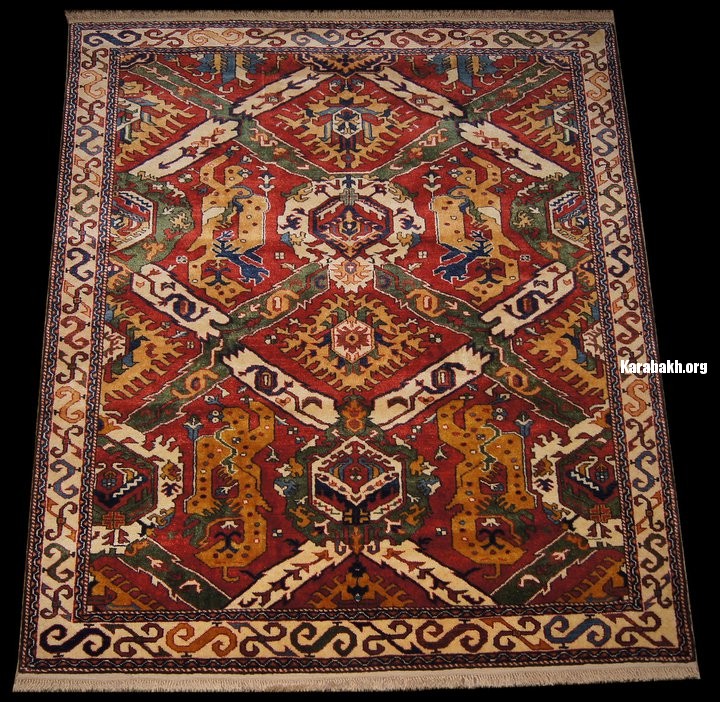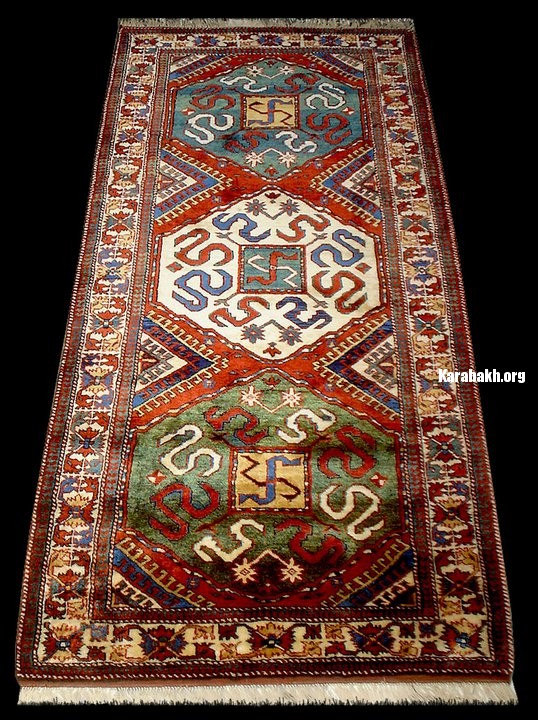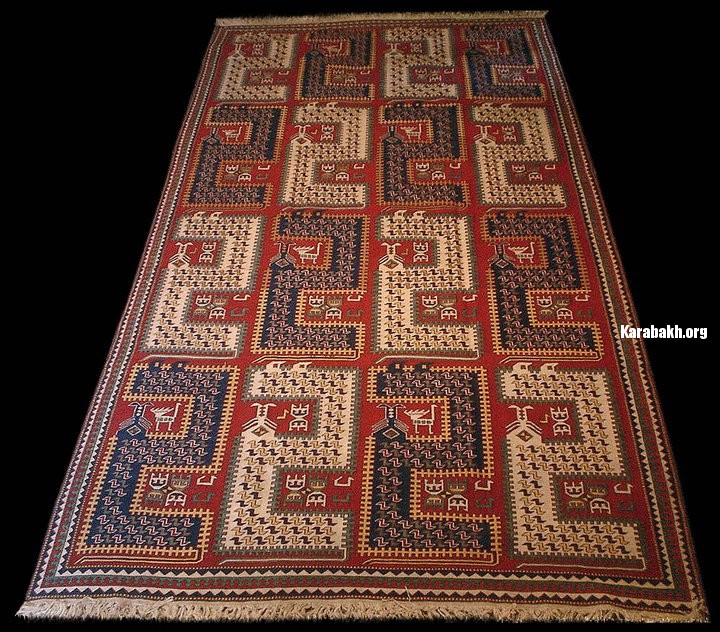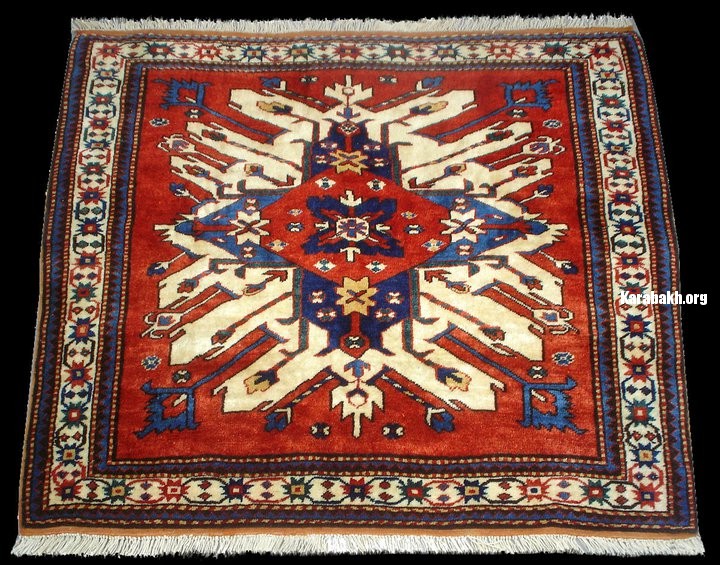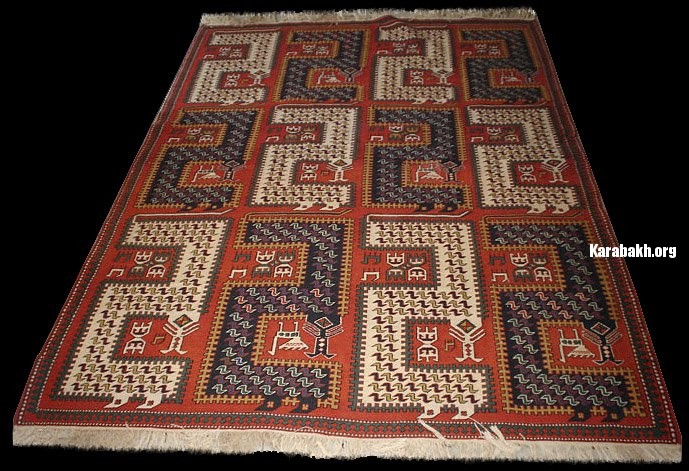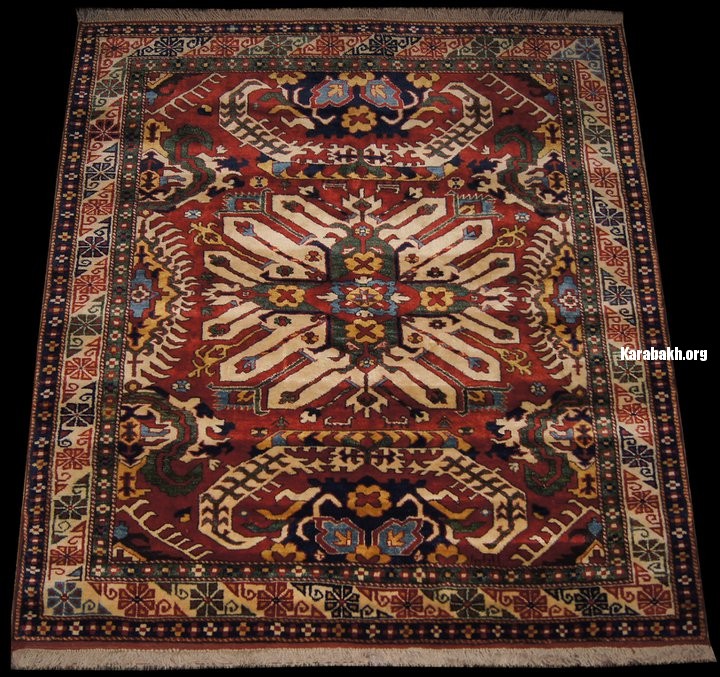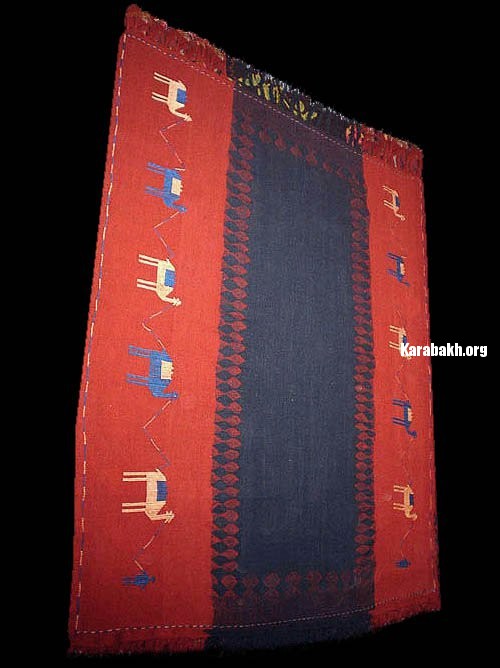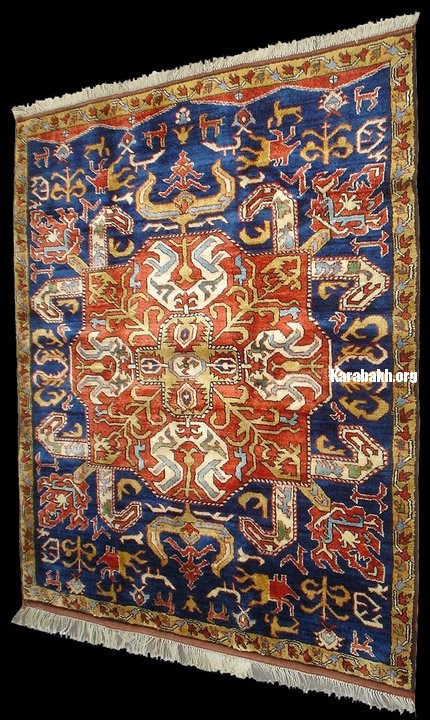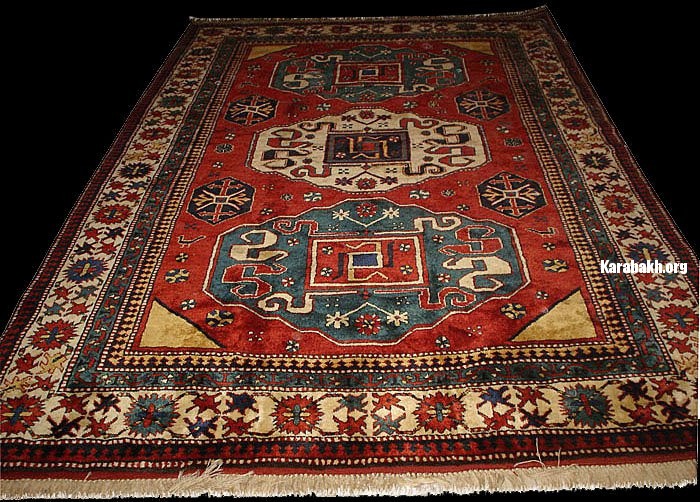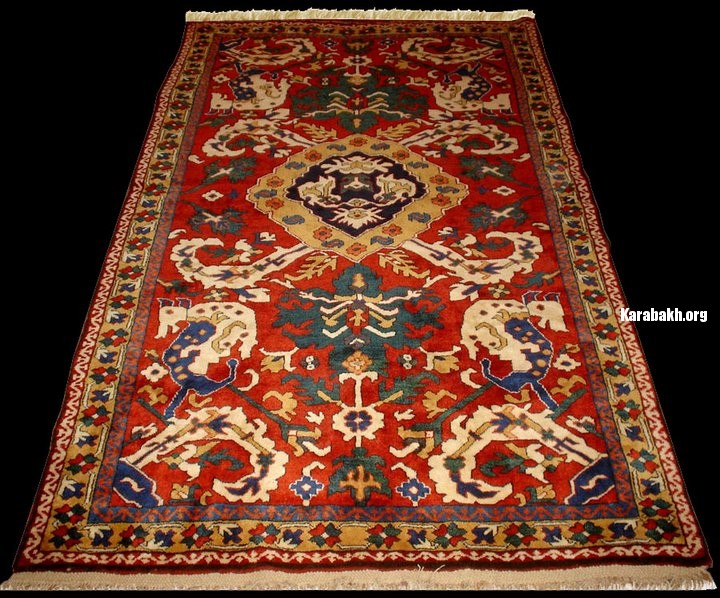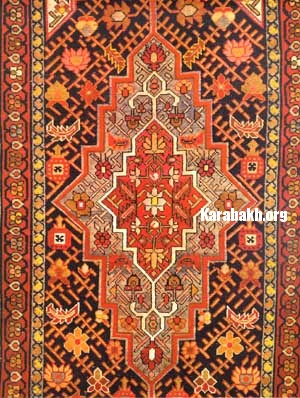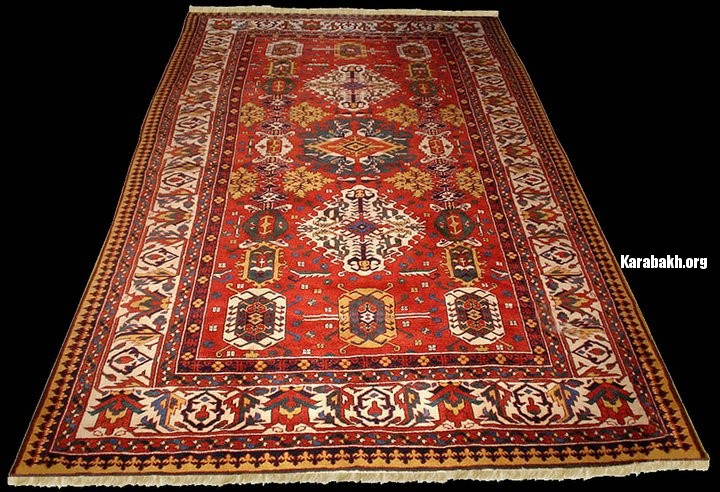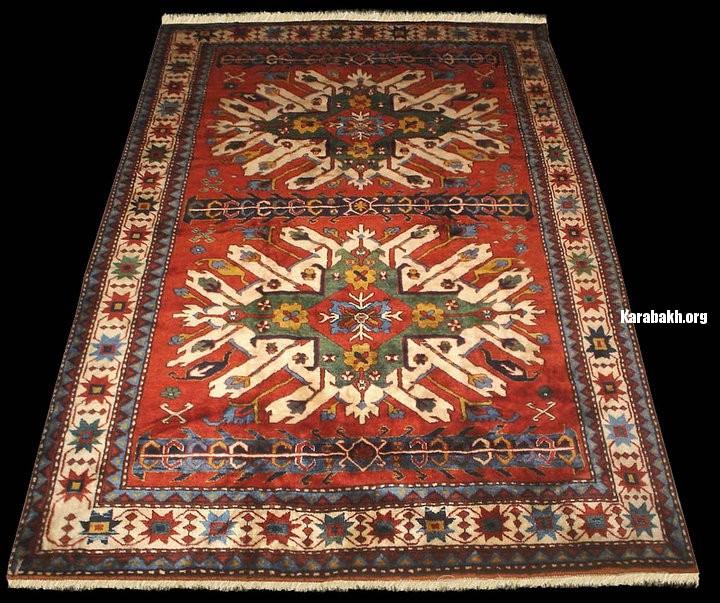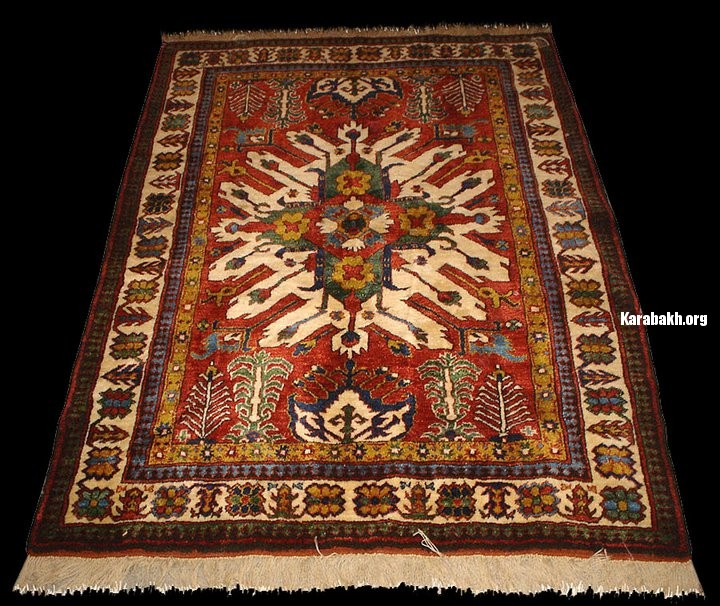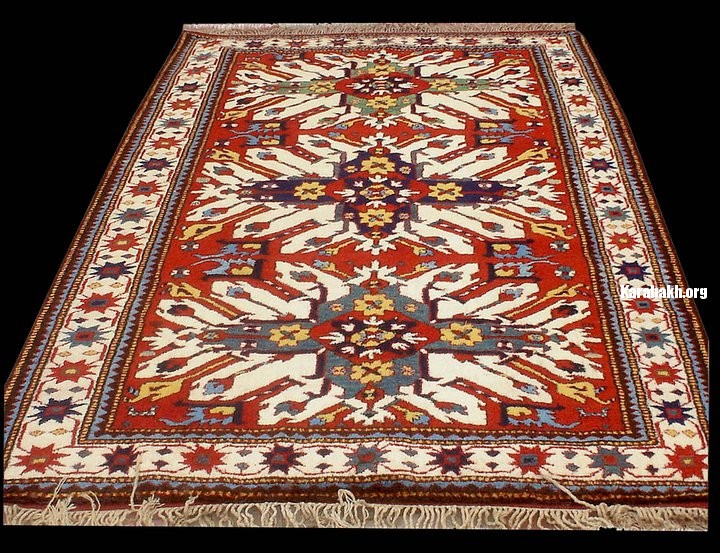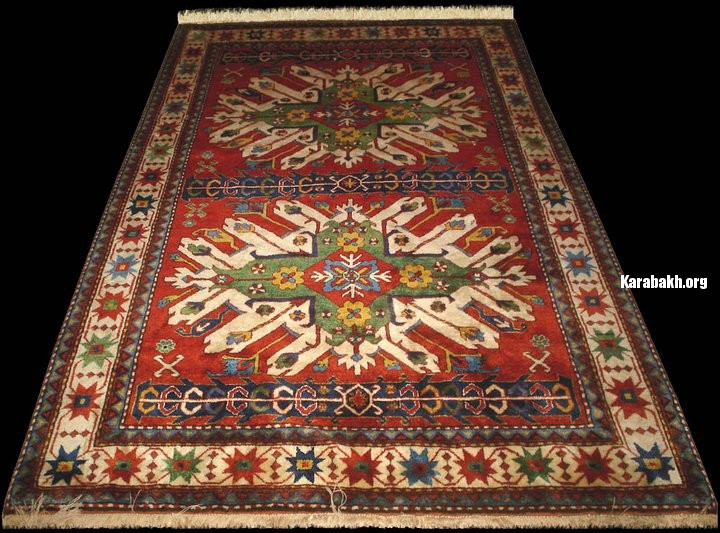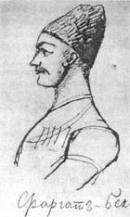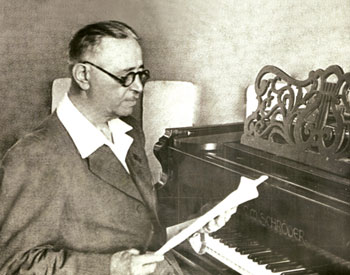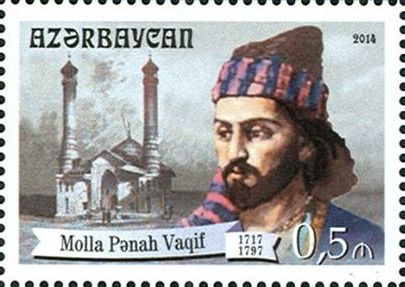The Karabakh carpets made up of 33 compositions. Due to the specifics of the local sheep wool, the Karabakh carpets are characterized by the thick, high and fluffy pile. These carpets distinguish themselves with their vivid and joyous colours. They are divided into four groups: without medallions, with medallions, namazlik and subject carpet. These carpets were made in the mountainous part of Karabakh – in Malibayli, Muradxanli, Dasbulaq, Cabrayil, and Horadiz and many other villages.
The Karabakh carpet school of south-western Azerbaijan developed in two regions – in upland and lowland areas. Written accounts by Arab historian al-Muqaddasi, Masudi and others indicate that beginning from the 10th century; two major centres of craftsmanship were engaged in wool and cotton production in the mountainous part of Karabakh.
The town of Susha and the villages of Dasbulaq, Dovsanli, Girov, Trniviz, Canaxca, Tug, Tuglar, Hadrut, Muradxanli, Qasimusagi, Qubadli, Qozag, Mirseyid, Bagirbayli, Xanliq, and Dag Tumas played a leading role in the carpet weaving in the 19th century. In addition to the mountainous region, the carpet weaving also had a special place in the better-equipped lowland areas of Cabrayil, Agdam, Barda and Fuzuli. Each of these centres had a lot of villages engaged in the carpet weaving for commercial purposes. Zangazur and Nakhchivan carpet weaving centres also considered as a part of the Karabakh carpet school due to their style, technological peculiarities and colours.
Aran, Bagcadagullar, Baliq, Buynuz, Barda, Bahmanli, Karabakh, Qoca, Qasimusagi, Lambarani, Mugan, Talis, Lampa, Malibayli, Xanqarvand, Xanliq, Xantirma, Calabi, Sabalidbuta, and other pattern carpet compositions are classic samples of the KarabakhSchool of the carpet making. A package of five carpet-rugs fitted to interiors of houses in Karabakh is widespread.
In early 1750, the khan of Karabakh Panahali laid the foundation of Susa. In the beginning the town was called Panahabad and was the capital of the Karabakh khanate for many years. In the 18th century the Karabakh carpet making school concentrated in Susa. In the 18th century along with the patterned carpets in Susa, new carpet compositions – Bagcadagullar, Saxsidagullar, Bulud and other patterns were woven copying designs of salvers, fragrant soaps, chintz and other wide-ranging home things imported from Russia and Europe. The palette of colour and dye of the Karabakh carpets is highly rich. This palette reflects the gentlest shades of colours of Karabakh’s wide-ranging nature. In addition to various plants, dyes were made of diverse insects there. We must do our utmost to liberate Karabakh – Azerbaijan’s integral part from the Armenian occupation and end the looting of our national resources. It is our duty to regain the control over our riches there. The motifs of the Karabakh carpets are peerless for their graphic value and originality.
Along with nice paintings, the Karabakh carpets previously contained hunting scenes, however, at later stage we clearly saw the lost of interest in hunting scenes by carpet weavers. They almost lack dynamic hunting scenes and only depicted attributes, symbols of the hunting. Later this process deepened further and in the first quarter of the 20th century, the hunting motifs completely disappeared as a topic, giving way to depictions of animals connected with another only for the sake of composition. This explains the impact of Sadda carpets on the piled carpets. Old pileless Sadda carpets are primitive for their composition and are made on principles of horizontal symmetry and similar type human and animal figures are repeated equally and endlessly. Having lost interests in complete hunting motifs, pile carpet weavers use the same artistic principle. For instance, at the end of 19th century pile carpets depicting horses and dogs, dogs and cats, deer and gazelles and so on were woven. As for the composition, they are horizontal stripes with depictions of animals. The Karabakh carpets, devoted to folklore hero and the character of the Sahnama (the Book of Kings) by the Persian poet Firdovsi, are incomparably beautiful. The series of Rustam and Sohrab carpets are worthwhile for proximity of the traditional compositions to the spirit of the people. These are incomparable pearls of the carpet-making profession for their idea and artistic features. The subject-based carpet making in the Karabakh school developed uniquely.
Buynuz
Buynuz carpets are characteristic of Karabakh. They are made at various carpet workshops of the Upper (Mountainous) Karabakh. Veteran Karabakh carpet weavers still refer to the Buynuz carpet by its old name, i.e. Horadiz. In Central Asia and Middle East, including in Azerbaijan, the horned cattle like ram, bull, goat were treated like holy animals. In association with farming, harvesting, and later with totemism and astronomy, the horn represented different notions and symbols. The bull as a source of strength and courage was at the same time considered a symbol of the heavenly forces and the embodiment of the God of water and agriculture. The composition of the central area is formed by totally stylized images of horns.
Similar-shaped elements that constitute the central square of the Buynuz carpets and decorations in line with the artistic traditions and the generally-accepted rules are lined up to form horizontal rows. On the one hand, the asymmetric arrangement of the “buynuz” (horns) enlivens the carpet; on the other hand, such arrangement makes it possible to weave carpets of any size. Details of various shapes and forms, which surround the “buynuz” as the key elements of the carpet, serve as filling elements.
Baliq
This carpet is considered to be one of the most common carpets of the KarabakhSchool. Well-known as Baliq in the north of the country, it is called Moxi in the Iranian Azerbaijan. Although the Baliq carpet is made at all carpet weaving shops across Karabakh, it’s primarily made in Barda. Since the second half of the 18th century, it was made in Susa as well. About 35 percent of the carpets and rugs made in Susa in the second half of the 19th century fell to the share of the Baliq kind of carpets.
The famous Eraq, Bicaq, Mustofi and other carpets were woven mainly on the basis of the Baliq pattern. The composition of the Baliq carpet largely follows the same principle with the spirals on the short length rapports. The leaves bent towards the end of the spiral (sometimes folded lengthwise) resembled the image of a fish; hence the conventional name of the composition is Baliq.
Karabakh
The carpets known under the name of Karabakh were and are still made at all carpet-weaving workshops across Azerbaijan. Depending on the location, the carpets were given different names but the art experts referred to all of them as Karabakh. This composition of the carpets, woven in Susa in 19th century for sale at Istanbul bazaars were given various names of Khan or Khan Karabakh, whereas the carpets woven on the basis of the same design in Quba were named Africa.
There are several types of the Karabakh carpets:
1. The composition of the central area that consists of several medallions mainly resembles the ornamental fabric of Iran and India, especially the curtains made of printed cloth. These medallions decorated with foliate elements can also be encountered on the Koran’s cover and on the jackets of the books designed by the Tabriz artists in the 15th-17th centuries. The titles in the upper and lower parts of the medallions fill the empty spaces between the medallions in the central area.
2. There are also Karabakh carpets that are referred to by carpet makers as Cini-cesni. The composition of these carpets is formed by octagonal medallions lined up in a row.
Xanlıq
Xanliq is the most famous carpet making centre of Azerbaijan. The carpets woven here still represent an example of the finest piece of art and are marked by top quality. The carpets made in the 19th century in Cabrayil, specifically in the villages of Mirzacanli, Afandilar, Daskasan, Suleymanli, were thought to be the most beautiful among those carpets exported to the world markets and fairs. In the middle of the Xanliq carpet there is a large medallion with two cubes in upper and lower parts and four petals symmetrically placed in the four corners of the central area. Typical selvages of the Xanliq carpets are stripes. The most peculiar samples of the Xanliq carpets, woven by special request, represent rugs of a complex composition. For example, in the 19th century, Xanliq carpets, commonly known as Xan qizi, were made under supervision of poetess Xursudbani Natavan.
Qasimusagi
The name of this Qasimusagi carpet is associated with the residents of the villages of Samkand, Arikli, Qurtasli, Corman and Sevna north of Lacin. Qasim was a respected man of his times there. These villages used to weave top quality carpets up to recent times. The composition of the central field of the Qasimusagi carpets is original from artistic point of view and consists of various details and elements.
In the centre of the carpet there is a large medallion surrounded by selvages. In the middle of the medallion, there is a tetrahedron medallion. From the sides of the medallion there are four pairs of scrolled branches, pointing sideward. In the lower and upper parts of the central area there is a pair of large “hands”, the shape of which is similar to the branches coming off the central medallion. Between these medallions (in the upper and lower parts of the large medallion) there are cubes, which are only typical to this carpet and chime in with the overall pattern.
Bahmanli
The name of this carpet is associated with the village of Boyuk Bahmanli in the present-day Fizuli District. The composition of the central field is formed by the figures of a peculiar shape, lined up in a row. Of special interest are the compositions with one or two figures in the central field. Veteran carpet weavers assume that these figures represent a statue, a brazier or the paw or a foot, others believe that this is an image of a turtle. One can conclude that the figures resembling an animal were associated with the image of a turtle used to be a totem of a certain tribe.
Chalabi
The carpet was first made in the village of Chalabilar. The composition and the patterns of the Chalabi carpets were established and further perfected in this village. Later they spread on to the Mountainous Karabakh, Aran (lowland) and beginning with the 19th century, they were made in Qazax district carpet making as well. The composition of the central field of the Chalabi carpets is formed by one large or several large medallions lined up in a row. Their size is normally between 80 to 150 sm. These medallions are composed of 16 petals and imitate the curve-linear medallions created by the professional artists of the 14th – 16th centuries. It later lost its original form due to the technological processes. Imitation and adopted elements are also typical to the 18th century carpets found at the Bibi-Heybat mosque.
Mugan
Geographically, this carpet is classed under the Sirvan group. Technically, it should be regarded as a Karabakh type of carpet. In Azerbaijan, there are about 17 villages with the same name of Mugan: Mugan Gancali, Muganli, Muganclik, Mehrab and Mugancik Muslim. However, the carpets are famous under the name of a vast area in the south-eastern Azerbaijan called Mugan or Mogan.
The 10th century Xudud al-Alamin mentions that a lot of rugs and cuvals were made in Mugan. The décor of these carpets is mainly composed of the hook-like elements called Kohna naxis by carpet weavers. These elements widely used in the carpet art of Azerbaijan dated back to ancient times and can also be encountered in the carpets of Central Asia and Afghanistan.
Talis
This carpet derives its name from a large area that spreads along the Talis mountain range on the Caspian seashore. The central part composition of the Talis carpets is both simple and complicated. Previously, the Talis carpets were made of silk. Starting from the third quarter of the 19th century, they were made of wool and cotton.
The carpets are rough from the point of view of the weaving technique with a smooth monochrome central field or decorated with tiny elements and were of simple composition. The elongated carpets with medallions called “paxlava naxis” are of complex composition. These medallions that come one after another and are similar in shape but differ in colours form a peculiar decorative composition.
Nakhchivan
These carpets are largely made at carpet weaving centres of Nakhchivan and are located in the villages of Norasen, Sahbuz, and Kolani as well as at the carpet making points of Culfa and Ordubad. Naxcivan is an ancient city of Azerbaijan. In the 9th-10th centuries, the city was renowned for its zilli and rugs, and in the 10th-12th centuries, it was a centre of production of decorative metal plates. When Evliya Chalabi, famous Turkish traveler of late 16th – early 17th centuries, visited Naxcivan he called this town Naqimcahan and praised its architectural monuments and arts centres in his books. The carpets made in Naxcivan varied for their ornamental pattern, however, all of them are called Naxcivan.
Karabakh Rugs and Carpets Gallery
See also: http://www.azerbaijanrugs.com/arfp-gallery-karabagh_rugs1.htm
